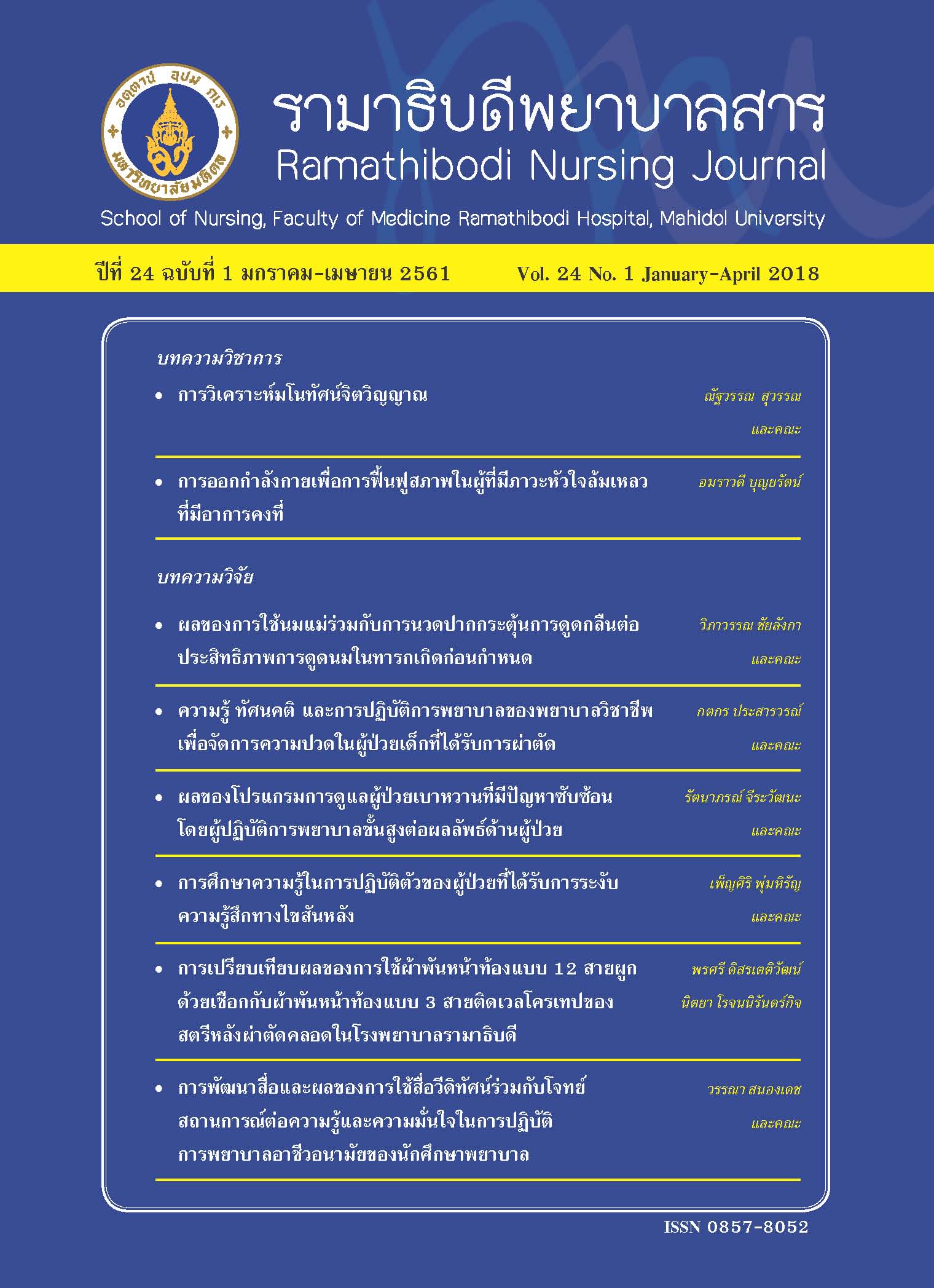A Comparision of Using the Twelve-String Abdominal Binder and the Three-String Abdominal Binder with Velcro Tape in Women after Caesarean Section at Ramathibodi Hospital
Main Article Content
Abstract
The effect of using abdominal binder for wound pain relieving in caesarean section mother at Ramathibodi Hospital
Pornsri Disorntatiwat, M.Sc. (Biostatistic)*
Nitaya Rotjananirankit , M.N.S. (Nursing Administration) **
Abstract: This quasi-experimental study aimed to compare the pain scores, the satisfaction scores of caesarean section women and nurses after using the twelve string abdominal binder and the three string abdominal binder with velcro tape, and the duration of abdominal binder. The sample of 20 caesarean section women and 23 nurses in postpartum ward at Ramathibodi Hospital were purposively selected. Research instruments were pain ascessment using the numeric rating scale and the satisfaction questionnaires after using abdominal binder. Theirs Cronbach alpha coefficients of the instruments were 0.96 and 0.89 respectively. Mean, standard deviation, pair t- test, and multilevel mixed effects linear regression were used for data analysis.The results showed that mean of pain scores before using both abdominal binder had higher than after using both abdominal binder significantly. The mean different of pain score after using both abdominal binder were not different. The overall satisfaction score of caesarean section women were not different.The nurses had overall satisfaction score of using the three string abdominal binder with velcro tape higher than the twelve string abdominal binder significantly. The duration of using the three string abdominal binder with velcro tape less than the twelve string abdominal binder significantly . This study findings suggested the used of abdominal binder with velcro tape in order to relieve pain for caesarean section women.
Key Words: abdominal binder, pain, caesarean section women
Article Details
บทความ ข้อมูล เนื้อหา รูปภาพ ฯลฯ ที่ได้รับการตีพิมพ์ในรามาธิบดีพยาบาลสาร ถือเป็นลิขสิทธิ์ของวารสาร หากบุคคลหรือหน่วยงานใดต้องการนำทั้งหมดหรือส่วนหนึ่งส่วนใดไปเผยแพร่หรือเพื่อกระทำการใด ใด จะต้องได้รับอนุญาตเป็นลายลักษณ์อักษรจากรามาธิบดีพยาบาลสารก่อนเท่านั้น
References
(in Thai)
2. Good M, Stanton-Hicks M, Grass JA, Anderson GC, Makii M, Geras J. Pain after gynecologic surgery. Pain
Manag Nurs. 2000;1(3):96-104.
3. Portet M, Van Teijlingen E, Chi Ying Yip L, Bhattacharya S. Satisfaction with ceasarean section: qualitative analysis
of open–ended questions in a large postal survey. Birth. 2007;34(2):148-54.
4. Pinchaleaw D, Serisathien Y. Women’s distress after cesarean section. J Nurs Sci S1. 2009;27(2):28-38.
(in Thai)
5. Ghana S, Hakimi S, Mirghafourvand M, Abbasalizadeh F, Behnampour N. Randomized control trial of abdominal
binders for postoperative pain, distress, and blood loss after cesarean delivery. Int J Gynecol Obstet. 2017; 137(3):
271-6.
6. Melzack R, Wall PD. Pain mechanism: a new theory. Science. 1965;150(3669):971-9.
7. Kolcaba K. Comfort theory and practice: a vision for holistic health care and research. New York: Springer;
2003.
8. Kamolwit S, Rattanapathumwong P. Development of clinical practice guidelines for pain management in postoperative patients in Ranong hospital. Journal of Nursing Division. 2014;40(2):23-40. (in Thai)
9. Chang K. Dimensions and indicators of patients’ perceived nursing care quality in the hospital setting. J Nurs Care Qual. 1997 Aug;11(6):26-37.
10. Glass GV, McGaw B, Smith ML. Meta-analysis in social research. Sage: Beverly Hills; 1981.
11. Kusuwan N. An effect of using Nuanjan Belly Band on comfort of women after caesarean section; 2012 [cited
2017 May 1]. Available from: https://www.gj.mahidol. ac.th/tech/FileDownload/File/D150511175633.pdf
(in Thai)
12. Cohen J Z. Statistical power analysis for the behavioral sciences. 2nd. Hillsdale, New Jersey: Lawrence Erlbaum
Associates, Publishers; 1998.
13. Mc Caffery M, Beebe A. Pain: clinical manual for nursing practice, Mosby St. Louis, MO; 1989.
14. Multilevel mixed-effects linear regression. StataCorp. Stata Statistical Software: Release 15. College Station,
TX: StataCorp LP; 2017. p. 514-45.
15. Nair A, Devi S. Obstetric outcome of teenage pregnancy in comparison with pregnant women of 20-29 years: a
retrospective study. Int J Reprod Contracept Obstet Gynecol. 2015;52(3):229-34.
16. Biro MA, Davey MA, Carolan M, Kealy M. Advanced maternal age and obstetric morbidity for women giving
birth in Victoria. Australia: a population-based study. Aust NZJ Obstet Gynaecol. 2012;52(3): 229-34.
17. Wylie BJ, Gilbert S, Landon MB, Spong CY, Rouse DJ, Leveno KJ, et al. Comparison of transverse and vertical
skin incision for emergency cesarean delivery. Obstet Gynecol. 2010;115(6):1134-40.
18. Maaloe N, Aabakke AJM, Secher NJ. Midline versus transverse incision for cesarean delivery in low-income
countries. Int J Gynecol Obstet. 2014;125:1-2.
19. Szender JB, Hall KL, Kost ER. A randomized-clinical trial examining a neoprene abdominal binder in gynecologic
surgery patients. Clin Exp Obstetrics Gynecology. 2014;41(5):525-9.

